7 June 2014
Headphones 3D v2
New algorithm is purely time domain based.


7 June 2014
New algorithm is purely time domain based.
Even though our original Headphones 3D algorithm had been designed with computational complexity and memory requirements in mind (it could run on the smallest Blackfin with 32kB of program and data memory, also it run on an ARM Cortex M4 with less than 100 MHz), we have frequently seen potential applications, where the already low requirement was still too high (e.g. wireless bluetooth headsets with a modest DSP already busy with audio decoding). This was our original motivation to develop a new line of algorithms, with minimal MIPS and memory requirements.
The new algorithm is purely time domain based, but incorporating all the experiences we gained during the multi-year development of the original Headphones 3D. The head related transfer functions were replaced with a low complexity IIR-filter based model, enabling also “free” support head tracking.
Initially our goal was mostly to reduce MIPS and memory requirements, but it turned out that the new algorithm performs very well. Halving requirements, while improving performance, adding head tracking and in addition to stereo and 5.1, native 7.1 support.
Contact us for more information.


6 June 2014







Room equalization, when needed and done well, brings back fidelity and precision
Introduction
The weakest link of high quality audio systems is often the room in which they are in. Room equalization, when needed and done well, brings back fidelity and precision.
Full integration of room equalization in an audio system requires that the filtering is done just before the DA converter (DAC), to prevent that signals are converted multiple times between analog and digital. Additionally, the DAC has to have the capability to receive signals directly from all desired sources, motivating addition of a pre-amplifier in the same device. Illusonic Audio Processors are preamplifier, processor (room equalization and more), and DAC in one device. They can receive a wide variety of analog (line, phono) and digital (S/PDIF, HDMI, USB, ethernet) signals.
Manual, Automatic, and Illusonic Way
Many professionals and some ambitious consumers use manual room equalization. Usually a number of fully parametric equalizers per channel are used. The challenge is to optimally set the parameters. This task requires expert knowledge, experience, and is time consuming (requiring many iterations between changing equalizer parameters and re-measuring and listening).
To enable room equalization for the majority of consumers, automatic systems were introduced in recent years. The primary benefit of these systems is, that they are easy enough to use, to enable each owner of a corresponding device to use room equalization.
After several years of implementation, experimentation, and testing of automatic and manual systems, our conclusion was, that the manual approach with an experienced expert is much better. Additionally, the manual approach lets the user transparently see what is being done.
Signal-processing-wise Illusonic room equalization comprises of a high quality implementation of well proven tools: gains, delays, and fully parametric equalizers per channel. For those who use it, also bass management is included.
Except for experts and ambitious hobbyists, measuring a room and setting these parameters is too complex. Therefore, Illusonic developed advanced software, IAP Calibration, and a remote tuning service:
A reseller or customer can conveniently make multi-point room measurements
These may be sent to Illusonic, which expertly sets the parameters (for free)
The customer conveniently loads the parameters into his audio processor
The customer may modify any parameters to his liking
This remote tuning service is made possible by IAP Calibration’s virtual tuning capability. As parameters are set, the resulting frequency and time responses are shown in real-time, without a need for iterating between measurement and parameter setting. Virtual tuning is of course also available to all customers, we use the same IAP Calibration tool as is available to everyone.
Illusonic Room Equalization is a system, enabling top-notch room equalization, otherwise only possible by using an experienced expert for the task.
In the following, we are discussing room equalization strategies for those who are interested. To implement these strategies with conventional manual measurement tools is very complex and time consuming. The goal of our IAP Calibration software is to make it as simple and convenient as possible.
One-Point and Multi-Point Room Equalization
One Point Room Equalization
Sound that travels from a loudspeaker to a point in the room can be precisely modelled with a linear finite-impulse-response (FIR) filter. Inversion of such filtering is under normal circumstances ill-conditioned, i.e. practically not possible.
Except for special simple cases, one point room equalization can only attempt to flatten the frequency response, while attempting to keep damage to the phase response small (compared to the case without room equalization). Usually this means that one does not attempt to correct every frequency response fluctuation, but only frequency-smooth trends. This is also advantageous, because flattening the frequency response in one point does increase fluctuations everywhere else.
If needed, a gain and delay correction between the loudspeakers is a no-brainer and will give clear improvements in the sweet spot.
For consumer audio systems, which usually not only serve listeners precisely in the sweet spot, one point room equalization is of little or no benefit.
Listening Area Room Equalization
Cinema and public address have been domains, where room equalization has played an important role for years. The goal is to provide good sound to as many seats in the audience as possible. An excessive focus on a single center position is counterproductive in this case.
In order to equalize a room for more than one listener position, one has to measure the frequency response at several positions, to see what is going on in the room overall. Given the measurements from each loudspeaker to several positions, the goal is to set the equalizers in a way that the sound on the average position improves.
Well done room equalization can give a benefit, even for the most audiophile systems. It can mitigate negative effects of room resonances, correct undesired asymmetries between loudspeakers, and correct undesired spectral defects arising from walls near loudspeakers and earliest reflections. Below, we’ll discuss strategies to set equalizers for achieving the before mentioned goals.
Illusonic Room Equalization
Signal Processing
All our audio processors feature room equalization, based on the same signal processing tools used by sound professionals:
channel gain and delay
fully parametric equalizers for each channel
The channel gain has the purpose to correct possible level errors between amplifier channels and loudspeakers. The delay is used, when different loudspeakers have a different distance from the center position (or preferred listening position).
The fully parametric equalizers are implemented as high precision (32/64 floating point) minimum phase biquad filters. They allow to spectrally correct each channel precisely, while keeping a corresponding undesired phase modification at minimum.
Room Measurement
Each loudspeaker is measured to multiple measurement (microphone) positions. The figure below illustrates different measurement positions:
the center of the sound system is measured
one or more listening positions are measured
a few positions distributed randomly in the room are measured
Remote and Virtual Tuning
The measurement data can be sent to Illusonic. We will manually determine good room equalization parameters, using IAP Controller’s virtual tuning capability.
You can also yourself set (or modify our) parameters, using IAP Calibration and virtual tuning. In the following, we describe room equalization strategies.
Gain and Delay
When doing room equalization without favouring a specific listening position, gain and delay for each loudspeaker are determined relative to the center position. Alternatively, it can be determined relative to the favoured listening position. (Often favoured listening position and center are the same. If you have, for example, a sofa with two seats both not in the center, then they differ).
Room Resonances
The figure below illustrates example room resonances. Between each pair of parallel walls, sound is bouncing back and forth, forming a standing wave. The maximum and zero position of such a standing wave has a time invariant position. Thus, the level of the room resonance depends on the specific listening position. The listener in the figure above hardly hears the first (red) room resonance (because he is positioned near its zero), while the second (blue) room resonance is very loud (because he is positioned near its maximum).
Room resonances can compromise the sound quality in two ways:
resonance frequency is too loud or too soft at listening position(s)
resonance is heard between transients (bass booming)
Low frequency absorbers weaken resonances, but are often not a viable option for a living room (cost, size). By varying loudspeaker and listening positions one can optimise the balance between the different resonances. However, often the degree of freedom for choosing loudspeaker and listening positions is not high enough to sufficiently solve the room resonance problem without equalizing.
For each loudspeaker, each room resonance is treated like this:
Identify the listening position where the resonance is most dominant
Attenuate the room resonance as much as needed
Room resonances are best tuned while listening to test signals. IAP Calibration software allows to play back test signals, while modifying parameters:
Play pink noise and attenuate the resonance until level is sufficiently reduced
Play low frequency pulses and further attenuate until bass booming is gone
The above figure shows an example. The blue curve is the listening position’s frequency response with two room resonances. Correction 1 is the one carried out with a pink noise test signal. A low frequency pulse test signal may result in more attenuation, as shown as Correction 2.
Loudspeakers Near Walls
Loudspeakers are often positioned at or near walls. The effect of this is an undesired low frequency boost. Typically, loudspeakers near room corners exhibit a 7 dB boost and loudspeakers near walls a 4 dB boost.
Such a low frequency boost exhibits everywhere in the room. Thus it can be corrected, improving the sound in the whole room.
A correctable low frequency boost (or any other correctable whole room effect) can be identified as follows:
Compare frequency response in the listening position(s) to the average frequency response over all measurement positions
Tune equalizer to correct common undesired trend
The figure above shows an example correction. IAP Controller software allows you to simultaneously view listening position(s) and average frequency responses, similary as illustrated in the figure above.
Dominant Early Reflections
Dominant early reflections, such as floor or ceiling reflections also give often rise to whole room spectral distortions which can be corrected.
A floor or ceiling reflection often reveals as a frequency loss of a few dB’s at 2 to 4 kHz. The correction strategy is the same as for loudspeakers near walls, i.e. correct the common trend in listen position and average frequency responses.
Deviations Between Loudspeakers
Spectral deviations between loudspeakers are corrected with a similar philosophy: correct trends which manifest in the listening position(s) and the average over all measurement positions.
The figure above shows an example of correctable spectral left-right loudspeaker deviation: the deviation of frequency responses from a left and right loudspeaker to the listening position(s) is similar to the corresponding deviation considering the average over all measurement positions. In this case, an equalizer is tuned to correct the undesired peak in the left loudspeaker frequency responses.
House Curve
So far, we have treated spectral defects in each loudspeaker frequency responses and differences in frequency responses between loudspeakers. Usually, for an audiophile application, this may be all that is desired. That means, the room and loudspeakers shall keep sounding as without room equalization, while undesired frequency response defects are mitigated.
When looking at the frequency responses of the same system measured in different rooms, one will notice differences in the overall shapes thereof. Different rooms result in more or less decay of sound towards the high frequencies, denoted house curve. If a specific room is perceived as being “too brilliant” or “too muffled”, one can additionally apply the same equalizer to all channels to modify the high frequency decay of the frequency responses.


6 June 2014
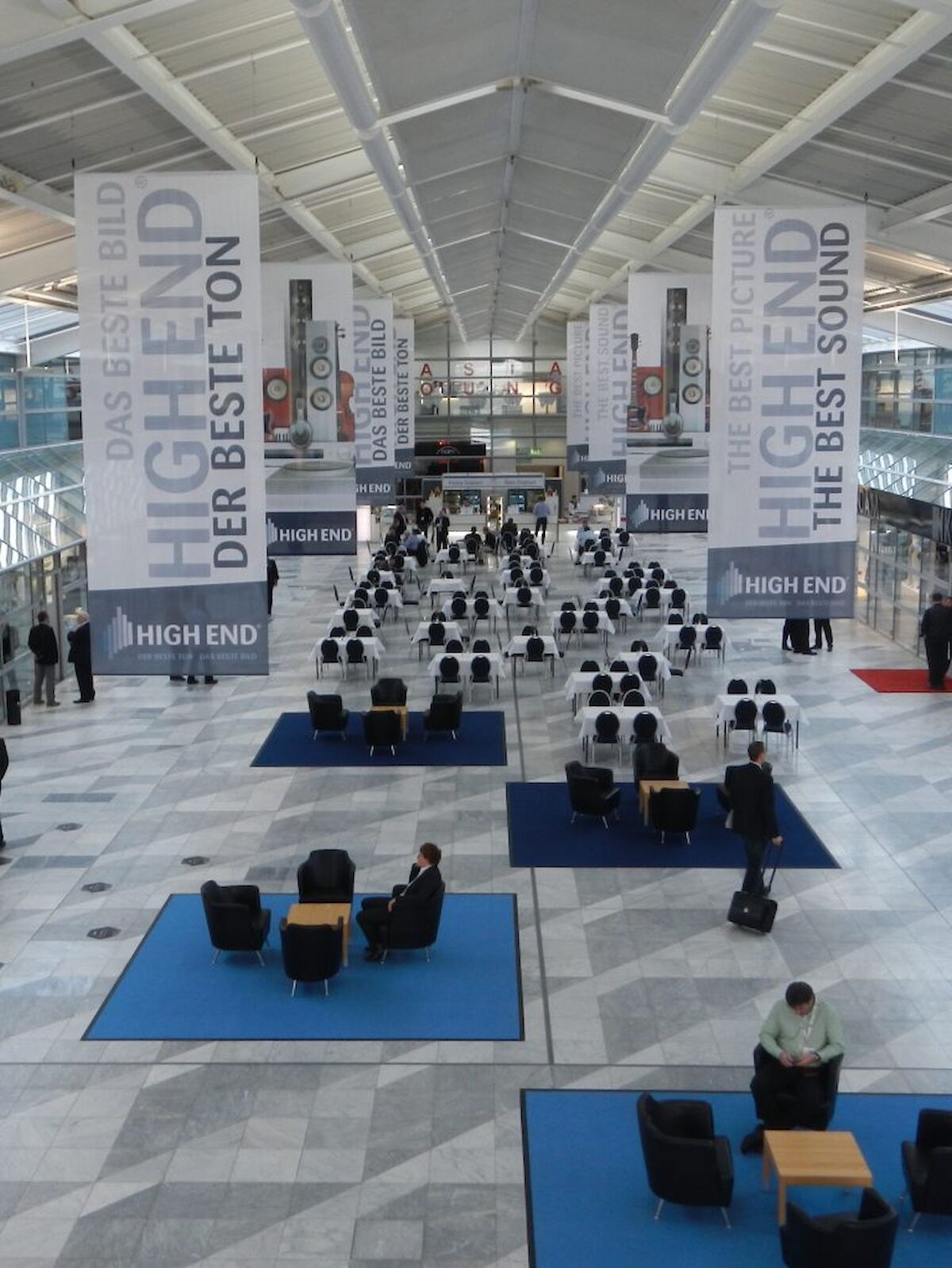






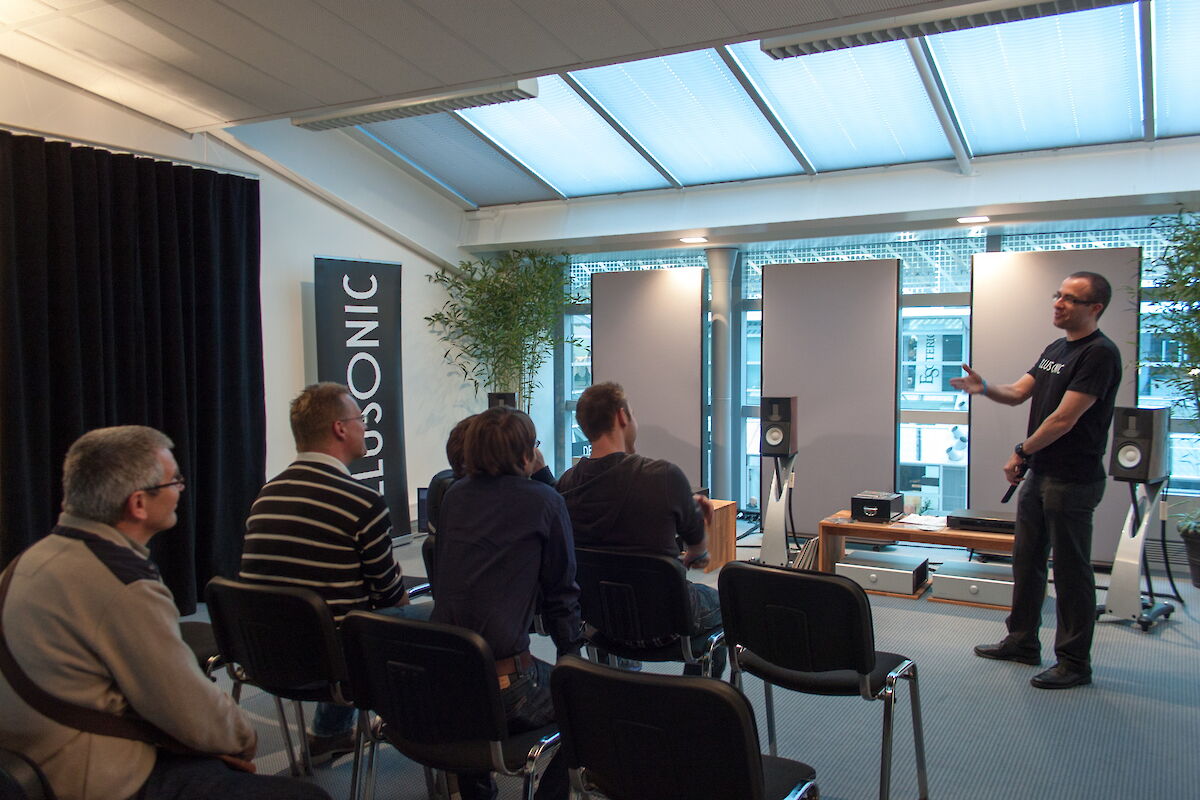


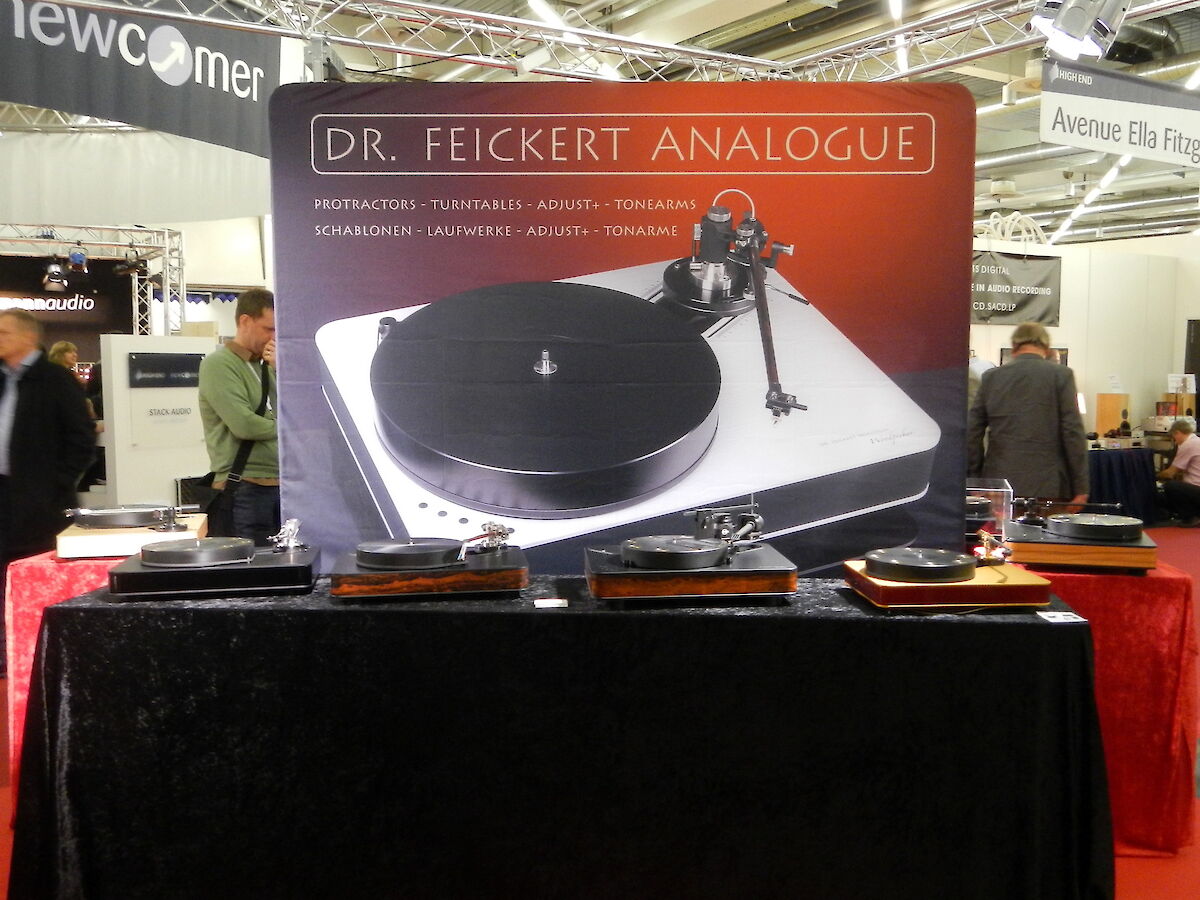



High End Munich has grown to be one of the largest high end audio shows world wide.
Illusonic being a small and new player in high end audio, focuses at this point mostly on this world-relevant show, plus a few other local smaller Swiss shows.
Illusonic’s traditional business is to invent & develop breakthrough audio technologies, and to license these to pro-audio and consumer electronics companies. Additionally, Illusonic develops specific technologies for customers, in areas such as international standardisation (MPEG, ITU) and consumer electronics (speakerphones, smartphones, tablets, TVs, cams, etc.).
Starting in 2010, High End Audio has been an ambitious new venture for Illusonic. Illusonic Audio Processors are Innovative first-grade audiophile hardware, coupled with Illusonic’s audio/acoustic/signal processing know how.
We were busy two full days, to set up our room. We were one of the earliest to start and latest to finish. We did not come with a detailed master plan, but improvised on site to optimise our room. For example, we purchased in Munich many lights to optimise lighting in our room. Yes, we have to become more efficient. But the longer we go on, the more we’ll have the experience and a pre-defined setup.
Like last year, we took sound quality very seriously. Again, we have treated our 65 square meter room modestly with absorbers, diffusers, and curtains from mb akustik. Renown sound engineer Patrik Schwitter, from Sunhill Project Studio, was again with us in Munich this year. On the picture above you see him tweaking the room equalization. As opposed to four hours last year, it took him only twenty minutes this year, thanks to pre-calibration with our new room equalization software.
The effect of room equalization was striking. Thus, besides the center channel demo, we had a second equally impressive demo! Once used to room equalization, switching it off made you feel like something was wrong. Not only in the sweet spot, everywhere.
Well deserved dinner after two long days before the show. Christophe, Markus, me (Christof), Renata, Patrik, and Corentin (from left to right).
On the show’s first day, we were ready with our 3-channel high end system, comprising of our new IAP 4 processor connected to:
Soulution power amps
Raidho loudspeakers
Vovox cables
Dr. Feickert turntable
mbakustik panels
Thanks to these generous companies for providing their unique equipment to Illusonic for the show!
Note that the turntable is directly connected to IAP 4’s digital phono stage. An Oppo universal player delivered LPCM signals to IAP via HDMI. The amplifiers directly connected to IAP4’s analog outputs.
The new IAP 2 and IAP 4 processors were on display.
We did not forget the venerable IAP 16, still by far the most flexible AV-Processor on the market. It was demonstrated with our setup and room equalization softwares. These softwares and also room equalization got much more traction than what we had expected.
The first people arriving. Most of the time, we played a high quality music selection on 3 CDs, selected by Patrik Schwitter. As people wished, we could switch in real-time between:
A: 3-channel presentation of stereo music (sound stage precision, large sweet spot)
B: stereo music
C: stereo music with room equalization off
In both cases, when switching from A to B, or B to C, people would often laugh visibly. This was an unambiguous sign that they heard the benefits of center channel and room equalization.
By comments from various people, we again had one of the best sounding rooms at the show! It has been worth the huge effort we had put into organisation and setup of the room. On the morning of the second show day, a journalist said: “The first time I am hearing music here at the show!”.
In the following, a few pictures from our equipment contributing partners (order by length of collaboration):
Soulution are famous for their beautifully set up and great sounding room at High End. Probably the show’s best sounding room. This year, they demonstrated their great amplifiers (and digital players and pre-amplifiers) with Magico loudspeakers and Critical Mass Systems racks. There was also no lack of a selection of Swiss chocolate.
Jürg Vogt from Vovox cables has again been a great supporter this year, providing complete custom cabling of our demo room.
It was an honor (thanks Chris Feickert!) to demonstrate our digital phono stage with one of the best turntables around: Dr. Feickert
Above you see the three absorber panels, one of two diffuser panels, and one of four curtains we installed to treat our room acoustically. Thanks to mb akustik and Home Acoustics Group for their advise and for contributing these acoustic elements!
After showing a massive 5.1 audio system with Focal loudspeakers last year, we wanted to show a lean system this year. Our new processors are compact digital preamplifiers, enabling the use of less equipment (IAPs are DAC, preamplifier, processor, equalizer in one device). This motivated us to show a lean system with small but good loudspeakers.
We wanted to be sure that we’d have a (small) loudspeaker adequate for the great Soulution 501 amplifiers we used. To be sure, I asked Cyrill Hammer from Soulution for advise. Our wish then was Rhaido C1.1. Thanks Raidho and Lars Krisitan Kristensen for your trust and generosity!
It was a busy week!
What I know now is: we have great first-grade sound quality. Be it IAP’s digital phono stage or DACs. After a decade of hard work, we got the center channel from stereo so well that it is almost universally well received. Same for room equalization, did not get a single critique
but many laughs when we switched it off.
We are one step further, in showing audiophiles that high end can be improved beyond the conventional. Indeed, the weakest link in a high end system at home is usually the room acoustic. It is a shame, without worrying about the room, first-grade equipment does not sound nearly as well as it could.


5 June 2014
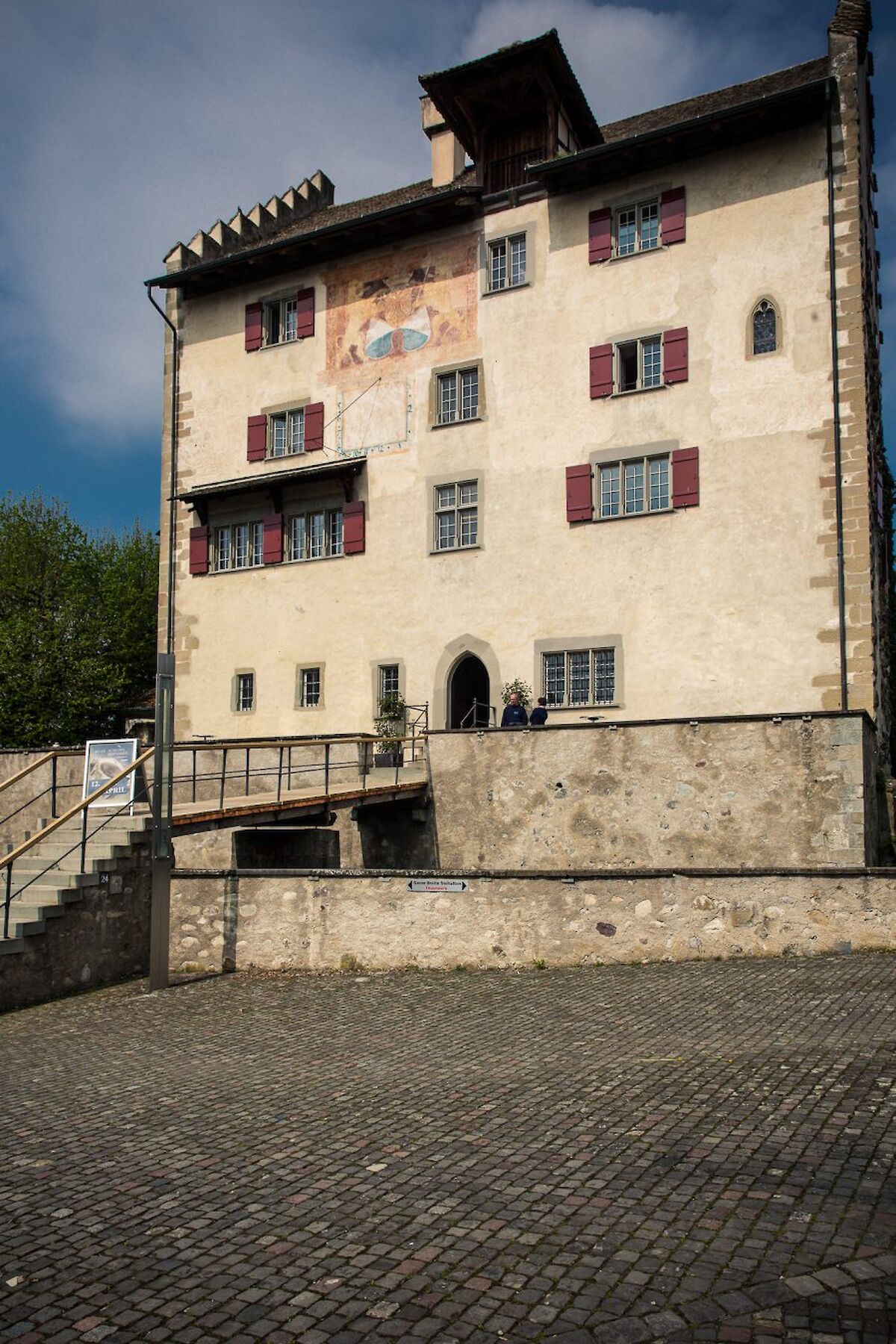









In the beautiful surroundings of lake, town, and castle Greifensee, the Klangschloss high end audio show has established itself as one of Switzerland’s main but still intimate show and more. With more are meant the concerts, talks, and culinary enjoyments which are offered with the show.
In 2011 we participated in Klangschloss, along with reputable Swiss loudspeaker manufacturer PSI Audio. Not with our own audio processor yet, but with a provoking 13.1 3D Surround demonstration. The loudspeaker system was fed with a multi-channel sound card driven by an Apple Macintosh, which would convert stereo music to 13.1.
This year, in 2014, we were back. Honored to share a room with loudspeaker manufacturer Klangwerk, or in other words with Markus Thomann, the founder and organiser of Klangschloss.
Markus installed a beautiful 5.1 setup. Left and right loudspeakers were Klangwerk Ella active loudspeakers. The subwoofer was not really visible, it looked like a designer table. A special very compact Klangwerk center loudspeaker was installed very discretely.
Even more discrete were the surround loudspeakers. My wife Renata’s comment to this setup was, that this is the first surround system she saw that she could imagine having at home (great – hurdle one passed – but our current apartment does not have the space for it).
Above, on top of the subwoofer table, you see what Illusonic showed. Our Immersive Audio Processor, fed with stereo and multi-channel PCM signals by an Oppo universal player via HDMI.
Playing plain stereo over the Ella loudspeakers, the system had already a remarkably robust sweet spot and spacious sound. A speciality of Klangwerk is, to design their loudspeakers with very frequency consistent directivity pattern, enabling consistent sound quality in the larger part of a room.
With these features, Klangwerk loudspeakers are also an ideal match for our Immersive Audio Processor. A sweet spot extension by means of center and surround loudspeakers can only work as well as the loudspeakers emit sound consistently into the room.
We played mostly stereo music and stereo converted to 5.1 by IAP, but also multi-channel music and movies. Sound quality of all configurations was well received. The challenging castle acoustic was successfully addressed by Illusonic’s new room equalization system.
Thanks for coming, Max, Lisa, Renata!
Once visitors have heard enough or needed a break, coffee, wine, and food was served on the ground floor of castle Greifensee.
On the second day of Klangschloss, there were a few seminars. The first one was given by renown sound engineer Jürg Jecklin on the history of sound recording from mono to surround. Over the great PSI Audio 5.1 system, installed in the lecture hall, Jürg played many historical and modern recording demonstrations.
I gave a talk about center channel and surround systems. Over the 5.1 system I demonstrated spatial hearing illusions (to demonstrate to the people how our spatial hearing works and what limitations of stereo are) and different usages of center and surround channels. This included also a demonstration of presenting stereo music over a 5.1 loudspeaker system.


2 March 2014

in Room E222
We invite you to visit us at High End 2014 in Munich, May 15-18, in Room E222 (Atrium 4.2). We will demonstrate our extended family of high end audio processors.
Besides of the Processors, our amazing sound setup comprises of:
Soulution power amps
Raidho loudspeakers
Vovox cables
Dr. Feickert turntable
mbakustik panels
Additionally, I will give every day a presentation on the High-End Technology Stage: “Strategies for Room Equalization of High End Systems”.
Thursday, May 15, 2014: 12:00 – 12:25
Friday, May 16, 2014: 12:00 – 12:25
Saturday, May 17, 2014: 12:00 – 12:25
Sunday, May 18, 2014: 12:00 – 12:25


7 December 2013









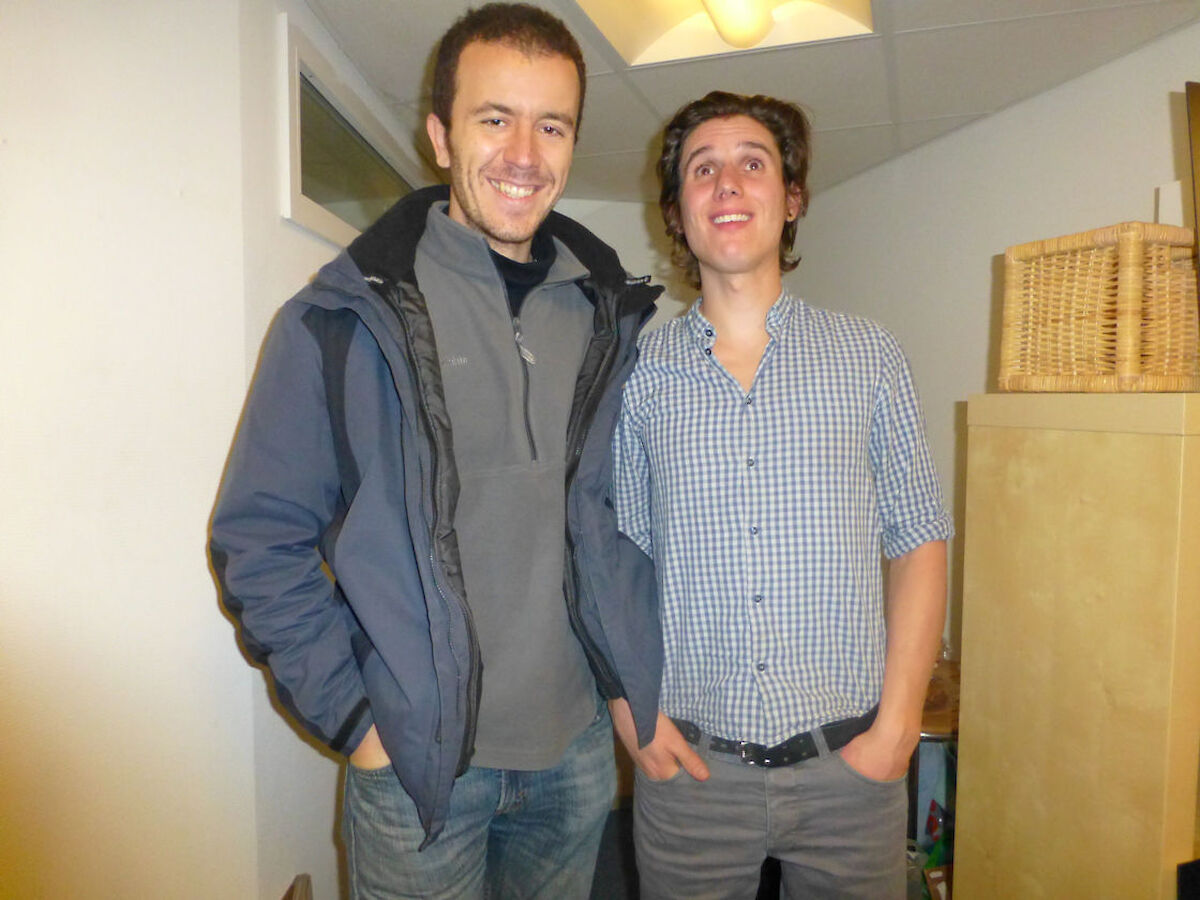
The 7th edition of our Pre-Christmas Party took place the evening of Thursday December 5th at our offices in Lausanne.
Originating as house warming party for our new office in Lausanne city in 2007, the 7th edition of our Pre-Christmas Party took place the evening of Thursday December 5th at our offices in Lausanne.
As always, our office was re-arranged (moved desks and things on the side), and plenty of finger food and drinks were served.
Besides friends and family, friends from local audio industry visited.
Such as from ABC PCB, Digimath, Klangwerk, Merging, Logitech, PSI Audio (Relec), Silent Work, Radio Materiel, Sonosax, Stenheim, and Stereolith.
Also, friends from the reknown local technical university, EPFL, visited (where I still teach an audio course in the fall semester).
We also welcomed friends from Lausanne University UNIL, which we got to know through a hobby bird-related audio analysis project.
At 8pm there was a short review on Illusonic’s year 2013. A highlight was our venture into high-end audio hardware business and our experiences with related trade shows.
Otherwise, the evening was without formal program.
While the first edition of the party still lasted until 5am, we closed around midnight this year. Because we might get older, or more reasonable.
Good night!


24 October 2013
After two to three years of work, we are finally ready to announce that our one-channel de-reverb algorithm is available for all commonly supported platforms (floating point, fixed point DSP, integer ARM).
Given any signal, no need for multiple microphones or channels, de-reverb attenuates reverberation. It makes a speech signal sound as if the talker is very close to the microphone, i.e. hands-free sounds more like higher quality headset recorded speech.
Also applicable in the professional domain, de-reverb removes annoying room effects from dialogue and interview recordings.
With hindsight obvious, de-reverb is effective against acoustic feedback, acting as a good acoustic feedback controller.
Contact us for more information.


22 October 2013









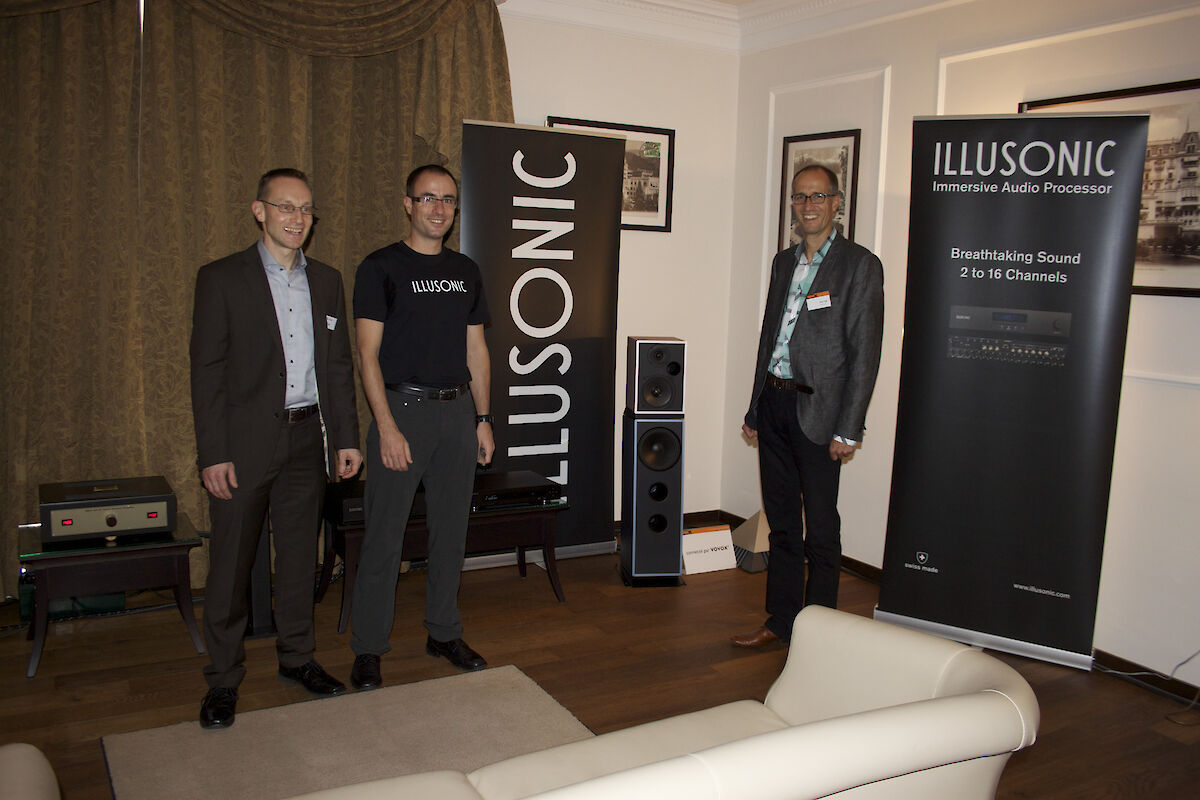

A show, not only for sound.
Sons & Sens 2013
In its third edition, Sons & Sens was held for the first time in Montreux, famous for its Jazz festival and beautiful surroundings. Exclusively Swiss high-end audio brands showed their latest and greatest offerings, including a few newcomers, such as Le Son, soundkaos, and us (Illusonic).
A show, not only for sound, but the “Sens” in Sons & Sens stands for other senses, such as local wines, food, chocolate, music, and art. These were implemented with other exhibits and evening social gatherings, resulting in a fresh atmosphere with partly a new audience, besides classic audiophiles.
With a respectable number of 18 exhibitors and its location in Montreux’s glamorous Hotel Suisse Majestic, Sons & Sons seems to be set for growth and more international vibes. This year, the number of visitors was still modest, though, resulting in an intimidate atmosphere. We were happy to have several in-depth interactions with well respected journalists.
Our Room and Setup
Our room was number 211, a junior suite with a balcony and beautiful view on Lake Geneva and the alps behind. Though we closed the curtains of the balcony window, to focus on sound and not distract listeners with too much light coming in.
Besides of the Processor, our 5.0 setup comprised of:
Battery powered 3-channel power amp by Audio Consulting for L, R, C
Two Nagra stereo amps for sub L, sub R, Ls, and Rs
Stenheim 5 main loudspeakers and two sub extenders
Vovox line and loudspeaker cables
An Oppo Blu ray player served as high definition digital source (CD, SACD, Blu ray) to our Immersive Audio Processor.
Before the show opened, we measured the room and set gain/delay trim for each loudspeaker and the sub extenders. Further, we used a single parametric equalizer for mitigating a slight room mode.
Show Report
Here a few reports by others on Sons & Sens 2013:
HIFISTATEMENT, Part 1 (German)
HIFISTATEMENT, Part 2 (German)
home-electronics.ch (German)
6moons.com (English)


3 September 2013
Montreux, October 11-13
We invite you to visit us at Sons & Sens in Montreux, October 11-13. We will demonstrate our revolutionary Immersive Audio Processor.
Besides of the Processor, our 5.1 multi-channel setup comprises of:
Power amps by Audio Consulting and Nagra
Stenheim loudspeakers
Vovox cables
An Oppo Blu ray player serves as high definition digital source (CD, SACD, Blu ray) to the Immersive Audio Processor.


16 June 2013














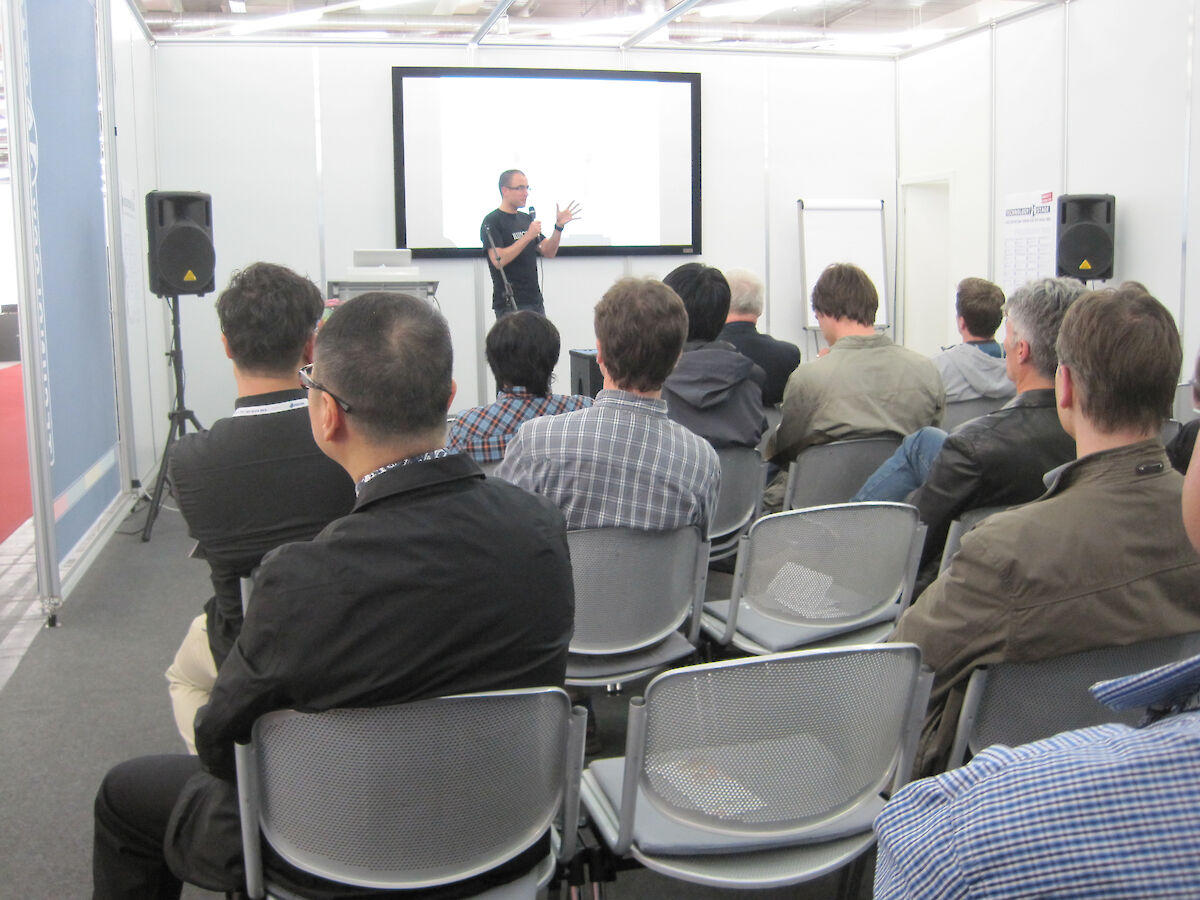
Demonstrating the versatile high-quality digital pre-amp Illusonic Immersive Audio Processor
What We Wanted to Show and Demonstrate
The demonstrated Illusonic Immersive Audio Processor is a versatile high-quality digital pre-amp, featuring in addition to the conventional audiophile common interfaces also latest HDMI 1.4a inputs and output.
Why would one want to have an audiophile pre-amp with 16 balanced analog outputs? To implement our unique immersive audio technology, which has the goal to reproduce existing music and movie sound tracks optimally over the given loudspeaker setup. With optimally we mean, enabling a sound experience like in the sweet spot, also for listeners which are not sitting in the sweet spot. Add a center loudspeaker to stereo to get a stable sound stage from everywhere. Or/and add surround loudspeakers to be immersed into the room of the music (no added reverb, but music-extracted room signal). Many setups and up to 16 loudspeakers can be used.
It is about getting great sound, for music and movies, on each seat on your sofa. Or an audiophile home cinema with great 3D immersive sound on each of its seats.
Demo Room Equipment
In the two days before the show, we prepared our demo room. We were lucky and thankful to be able to install highest quality and world-renown audio equipment:
6 Soulution Series 5 power amps
Soulution Digital Player
Dr. Feickert turntable with a Soulution pre-amp
Focal 5.1 setup with 5 Utopia III Viva and Sub Utopia
Vovox cabling (power, XLR, coax, loudspeaker cables)
TAOC racks (Axiss)
mbakustik absorbers, diffusers, and curtains
The central control (“digital pre-amp”) connecting this setup was our Immersive Audio Processor, which additionally connected to an Oppo Blu ray player via HDMI 1.4a.
Fine Tuning and Calibration
The Immersive Audio Processor’s versatile calibration capabilities were used. An initial calibration setting was derived from measurements throughout the 13-chair listening area (resulting in gain trim, delay trim, modest EQs, and bass management settings).
The night before the show, Patrik Schwitter fine tuned the calibration of the system until midnight, to improve low frequency response and to remove some “shoebox” sound which remained despite of the (relatively modest) acoustic treatment. Patrik used our new Immersive Audio Processor calibration tool, which presents an up to 16 channel mixing console with gain trim, delay trim, 5 fully parametric EQs per channel, and the many bass management parameters. Using this tool, Patrik could calibrate the system as he is used to: real-time like with a real mixing console, getting immediate acoustic feedback as he moved any control. This effort paid back, we got many positive comments on the overall sound of the room and system (also for stereo!).
Impressions and Reactions
Throughout the show, we used a single sound setting. No tweaking at all. Our goal is, that one setting is good for all music. That went well, we never felt we would have to change anything.
I was a bit anxious about the prospect of having many audiophile people exposed to our 3-channel stereo (left, right, center) and 5.1 for music and movies demonstration. We have had our system exposed to music professionals, acousticians, and a few audiophile people with good feedback. But it was hard to predict what the shock of listening to an unfamiliar 3 or 5 channel presentation of stereo music would evoke in an audiophile stereo and music lover.
The majority of feedback was overwhelmingly positive. We had many listeners staying long and coming several times again – listening carefully with closed eyes. The range of reaction was from being amazed (for example laughing out loudly as we switched to reference stereo), positive, to being a bit confused but positive. We got only very few negative reactions. Of course we don’t know the thoughts of the many people that just listened without saying anything. But not many people looked distressed or not pleased.
Technology Stage Presentation
Every day, I gave a presentation entitled “High Quality Stereo Reproduction Using a Center Channel”, to explain how a center channel is generated from stereo with the goal of sounding similar to the 2-channel stereo phantom center. I wrote a short version of this presentation as a blog.


1 June 2013




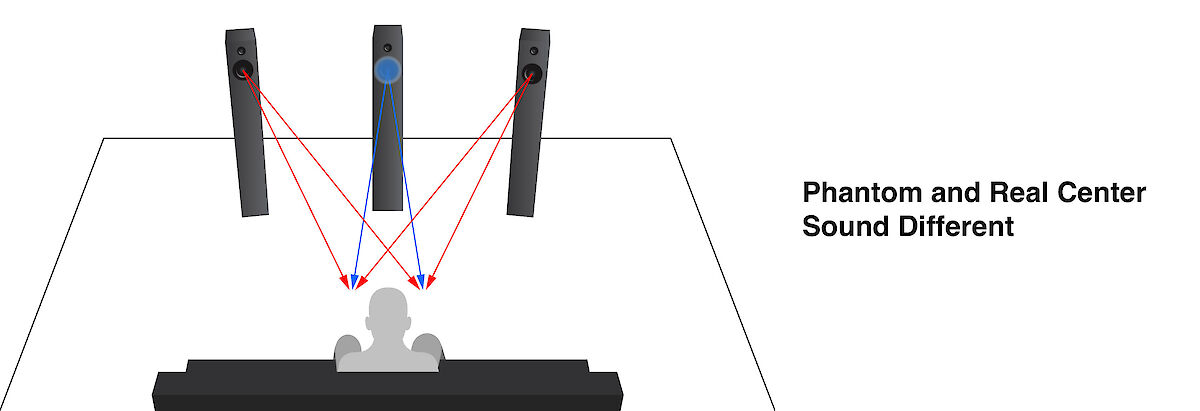



An economic and thus appealing setup.
Introduction
While our Immersive Audio Processor supports multi-channel surround loudspeaker setups with up to 16 loudspeakers, an economic and thus appealing setup is stereo with an additional center loudspeaker.
Stereo music is reproduced with a center loudspeaker with the goals of providing:
– highest quality
– a vastly improved listening experience for listeners that are not in the sweet spot
In the following, we are describing our strategy and challenges we faced for achieving these goals.
Stereo Sounds Great – In the Sweet Spot
High quality music, reproduced with a high quality stereo system, properly setup and assuming a good acoustic, enable a spatially remarkably faithful and rich listening experience. Phantom sources are perceived between the left and right loudspeakers and the listener is to a good degree immersed into the room/environment contained in the recording.
Much Is Lost – Outside of the Sweet Spot
If a listener is not in the sweet spot, phantom sources are perceived from the nearer loudspeaker. Immersion vanishes, making way to noticing being in the local room and “listening to loudspeakers” as opposed to instruments.
If a listener is in the sweet spot, but turns his head to the side, immersion vanishes, too.
Goal: Great Sound Everywhere
The goal is to enable a great listening experience for everyone, that is, not only for the person in the sweet spot, by using a center loudspeaker. The key to high quality is how the three channels (left, right, center) are generated from the given stereo music. In the following, we describe the three challenges we faced when developing this technology:
Extracting a Center Channel
Timbre of Center
Spaciousness of Center
Extracting a Center Channel
The goal is to extract a signal from the stereo signal, corresponding to the signal a listener in the sweet spot hears as a center phantom source. Localized sound is dry. Thus, a first step is to extract from the given stereo signal its dry part. The next step is to analyze the dry stereo signal and extract dry sound localized in the center. The so-obtained center signal is (scaled and) subtracted from the original left and right channels.
Timbre of Center
A listener’s head and body act as a filter to the arriving sound. This filter is different for sound from the side and center. Therefore, the same signal reproduced as stereo phantom center versus a center loudspeaker has a different timbre. For high quality stereo reproduction using a center channel, the center timbre has to be corrected such that it is similar to the original phantom center timbre.
Spaciousness of Center
A stereo phantom center is perceived as blurred. In contrast, a signal from a center loudspeaker is perceived very compactly. It is as if you “hear the loudspeaker” as opposed to a more spacious object like a stereo phantom center.
A phantom center corresponds to the same signal at the left and right loudspeakers. From these, not only direct sound reaches the listener, but also left and right early reflections. In contrast, early reflections from a center loudspeaker come mostly only from the center direction (back wall, floor, and ceiling reflections). Thus, a center loudspeaker is perceived as more focused than a phantom center.
Additionally, especially at high frequencies, the localization information available at the left and right ears is not precise and consistent for the phantom source, further adding spaciousness to its perception.
To add spaciousness to the center signal, center signal early reflections are added to left and right. The difficulty is to do this without impairing timbre and sound quality. Furthermore, at high frequencies, the energy of the center signal is spread to left and right.
Putting It All Together
The use of techniques for center signal extraction, timbre correction, and increase of spaciousness enables high quality reproduction of stereo signals using a center channel.
Disclaimer
Note that the functionality and functioning of Illusonic technologies and products may be modified at any time without notice. The algorithm descriptions above are for illustrative purpose only.


30 April 2013
Every hour, we will demonstrate our revolutionary Immersive Audio Processor.
We invite you to visit us at High End 2013 in Munich, May 9-12, in Atrium 4.2 Room E221. Every hour, we will demonstrate our revolutionary Immersive Audio Processor.
Besides of the Processor, our amazing multi-channel setup comprises of:
Soulution power amps and digital player
Focal loudspeakers
Vovox cables
mbakustik panels
TAOC racks
Dr. Feickert turntable
Additionally, I will give every day a presentation about “High Quality Stereo Reproduction Using a Center Channel” on the High End 2013 Technology Stage:
Thursday 12:30
Friday 16:00
Saturday 12:30
Sunday 12:30


4 December 2012



Consumer systems often use bass management for convenience and reducing cost.
Introduction
Consumer systems often use bass management for convenience and reducing cost. Bass management enables the use of smaller main loudspeakers, by reproducing low frequencies over a subwoofer.
The use of bass management and a subwoofer has been more popular for home cinema systems than for stereo systems,because for most people it is simply not practical having five or more large full range loudspeakers.
For high-end consumer stereo systems, subwoofers are hardly used. Why use a subwoofer if the main loudspeakers are large and truly full band?
While the optimal solution certainly depends on the specific case, there are situations when also high-end systems with full range loudspeakers benefit from bass management.
In the following, we are discussing and explaining bass management and reproduction of low frequencies with subwoofers. Even when all loudspeakers are full range and bass management per se would not be necessary, bass management can have its benefits.
Background: Room resonances
In this discussion, we are concerned about the impact of relatively late reverberation. Each pair of parallel walls of a room generates room resonances, that is, standing waves between the walls. The frequencies at which these room resonances occur are usually also the problematic frequencies at which reverberation decays too slowly, causing annoying “temporal smearing” and “bass boom” effects.
The figure below illustrates the sound pressure for room resonances occurring between two walls. The lowest frequency room resonance (shown in blue) has a wavelength twice as large as the distance between the walls. Thus, its frequency is:
f0 = c / (2*d) ,
where c is the speed of sound in air (about 340 m/s) and d is the distance between the walls. The frequencies of the higher frequency room resonances f1, f2, f3, … are:
fn = n * c / (2*d) .
When one measures a room, with the measurement loudspeaker and microphone located at two opposing walls, the corresponding room resonances appear as peaks in the spectrum. Above the so-called Schroeder frequency, the room resonances are so closely spaced in frequency that they do not appear as distinct spectral peaks.
Loudspeaker (Subwoofer) Positioning
When loudspeaker and microphone measurement positions are at or near peaks of the standing room resonance waves, as illustrated in the example in the figure above, the resonances appear as peaks in the spectrum. For general loudspeaker and microphone measurement positions, a room resonance may also appear as a notch in the spectrum. This occurs when either loudspeaker or microphone are positioned at or near a zero position of the room resonance. The figure below illustrates measurement or the room with the loudspeaker at a zero position, resulting in a spectral notch at the corresponding resonance frequency. Generally speaking, for an arbitrary loudspeaker and microphone position, each room resonance may appear as a peak, notch, or something in between.
Note also, that the energy transferred between an omni-directional loudspeaker and microphone by means of a room resonance remains the same if loudspeaker and microphone positions are swapped.
Now consider subwoofer positioning. The previously discussed loudspeaker position corresponds to the subwoofer position and the microphone position to the listening position. Given a pre-determined listening position (e.g. sweet spot of a stereo system), different room resonances are excited with different strength depending on the subwoofer position.
A good subwoofer position is reached when the room impulse response measured from subwoofer to microphone is as frequency smooth as possible. This occurs at a position at which the energy flow from subwoofer through the room resonances to the microphone is as frequency independent as possible.
The above mentioned condition does not yet ensure that the overall gain of the subwoofer signal matches the main loudspeakers. Thus, once the subwoofer is positioned, a gain calibration should be carried out.
The described positioning and calibration procedure may be carried out based on room impulse response measurements (you can use for example the free Room EQ Wizard). Less effort but more skill may required to optmize subwoofer positioning and gain by simply trying out different positions and listening.
Another method which may help for finding a good subwoofer position is to place the subwoofer in the desired optimal listening position and listen at all possible subwoofer positions whether bass is reproduced well. The point at which bass is reproduced well may be a good subwoofer position. This method is based on the above mentioned insight that loudspeaker (subwoofer) and microphone (listening) position may be swapped, while the energy transfer through room modes remains approximately the same.
Subwoofer Positioning II
In the previous section, subwoofer position optimized for a single optimal listening position (“swee spot”), was discussed. Especially for home cinema, but also whenever one intends to have more than one listener at a time, one should not only optimize the reproduction system for a single sweet spot.
One extreme example, to illustrate the problem of single sweet spot optimization, is the following. If the sweet spot is near a zero position of a room resonance, the subwoofer is potentially placed at a position where it excites this room resonance maximally. This likely leads to annoying “temporal smearing” and “bass boom” effects, for listeners which are not exactly in the sweet spot.
A good strategy for full room (or large listeing area) optimization is to measure the room resonances not only at the sweet spot, but at multiple positions. One way to optimize subwoofer position then is to optimize it in terms of spectral flatness with respect to the average room impulse response (averaged over all measurement positions).
Again, a skilled listener may optimize subwoofer positioning for an extended listening area by simply trying a number of subwoofer positions and listening at different positions.
Putting It All Together
So what has the previous discussion to do with a high-end stereo (or high-end surround) system with full range loudspeakers?
Low frequencies, below at least 80Hz, can not be localized by a listener. Thus, for perception of the stereo/surround image, it does not matter where the loudspeaker is, reproducing such low frequencies. For higher frequencies, it is crucially important that the main loudspeakers are at their appropriate positions.
It may be that the position of your main loudspeakers, due to your specific room, is suboptimal to reproduce low frequencies. If yes, it indeed makes sense to use bass managment to remove bass from the main loudspeakers and reproduce it over a well placed subwoofer.
Since in this case full range loudspeakers are used, the cross over frequency is chosen as low as possible, but such that most or all of the bass reproduction problems (“time smearing”, “bass boom”) occur below it.


12 October 2012


A fantastic state-of-the-art multimedia cocoon
Montreux Jazz Festival and EPFL (Ecole Polytechnique Federale de Lausanne) organized a press conference to launch the Montreux Jazz Heritage Lab. A fantastic state-of-the-art multimedia cocoon offers the opportuntiy to experience over 5000 hours of concerts from the last 45 years. The multimedia cocoon is powered by our Immersive Audio Processor, to reproduce the stereo Montreux Jazz archive over a 3D 10.1 loudspeaker system.
Montreux Jazz founder Claude Nobs: “I have the feeling to be into the concert hall. It is not just a normal sound. The sound envelops you. You are into the image, into the sound”.
Nicolas Henchoz, EPFL: “The aim of the Heritage Lab is to rethink our relationship with the digital world and to create another experience for AV archives”.
Pictures © Daniela Droz, Tonatiuh Ambrosetti / EPFL+ECAL, 2012.

